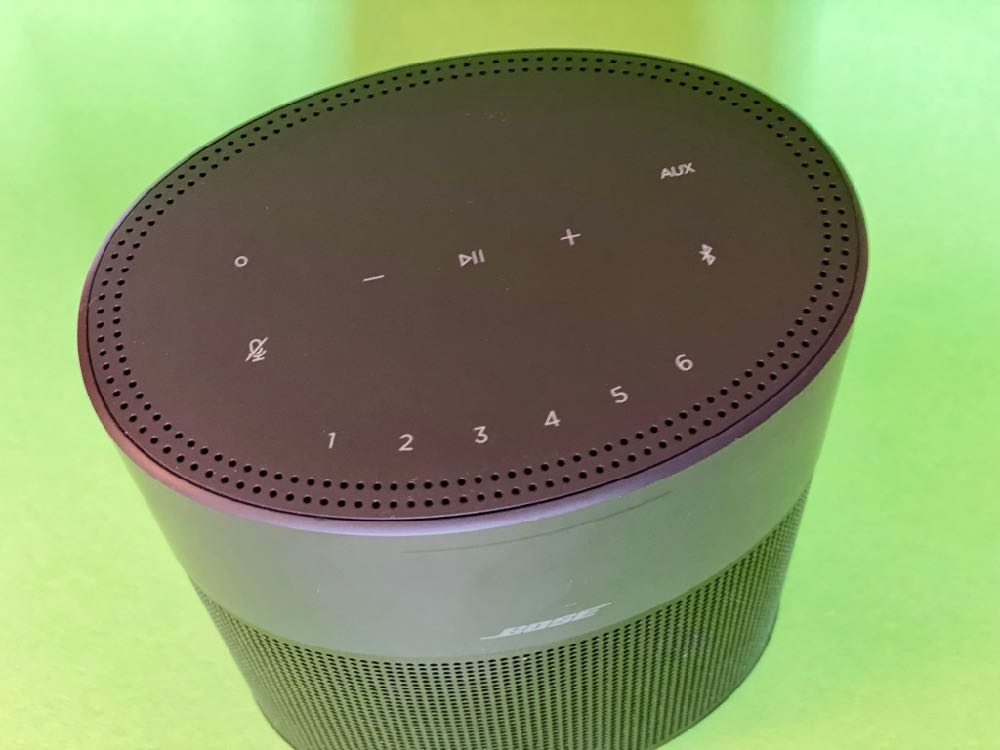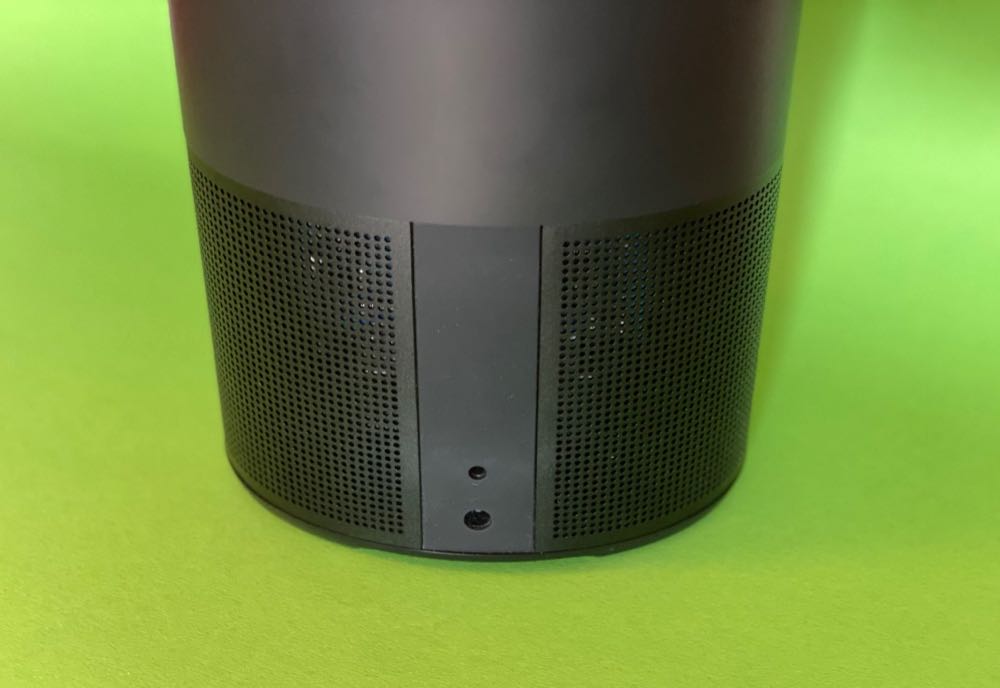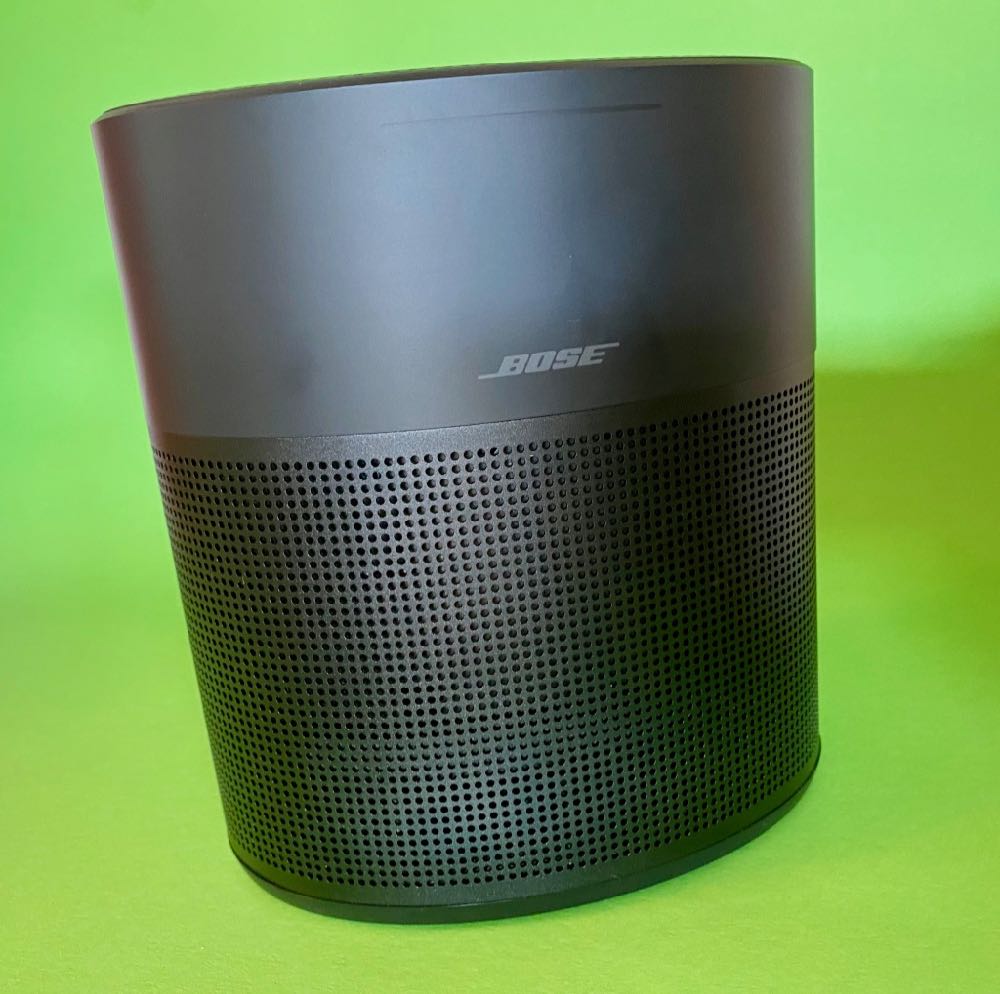STEREO GUIDE review
+ Full-bodied, pleasant reproduction
+ actually fills the whole room with music
+ Impressive bass for its size
+ flawless voice control with Google and Amazon
- staging/imaging very diffuse
- tends to be unclean at higher SPLs
- bass-rich music is limiting the SPL
-
Sound: Tonal Balance / Transparency7
-
Sound: Bass / Dynamics6
-
Ease-of-use / Connectivity8.5
-
Price/Performance8
The Bose Home Speaker 300 is the mid-size onebox system in the American manufacturer’s multiroom product family, and is advertised as a 360-degree sound machine, a reference to an omnidirectional feature that is meant to flood the whole room with soundwaves rather than just giving the illusion of ambience to a narrow sweet-spot. Available in black or white aluminium, the Bose is a classy indoor smart speaker that can also be used comfortably with Amazon Alexa or Google Assistant, but is very flexible in terms of playback options.
How the music comes to your Bose Home Speaker 300
While Bose does recommend their own app called the Bose Music App, the all-in-one speaker can also be easily fed music from compatible services. Spotify, Deezer and Amazon Music are available here.
For those who prefere simplicity, the Bose Home Speaker 300 can also handle a direct Bluetooth connection. This is very handy when you have visitors and want to be able to stream a few songs quickly, or to use a streaming service that Bose doesn’t support. For iPhone and iPad users in particular, AirPlay 2 would then be the protocol of choice, which also makes it very easy to connect to Apple Music from corresponding devices. Chromecast is not supported by the Bose Home Speaker 300, although Google Assistant is part of the concept.
The Bose is a little stingy with wired inputs, but it offers an analogue AUX input, so in case no other connection is possible on a digital level you can still send your music the traditional way to the compact oval speaker.
Voice recognition or buttons
To enable the most precise voice control possible through one of the integrated systems from Amazon or Google, the home speaker has an entire microphone array built right in, which reliably understands whispered commands even from a great distance. However, there is no visual feedback, only the bigger Bose Home Speaker 500 has a colour display on the front, here there is only a small light bar on top. This has limitations, of course, but works neatly in practice once you are familiar with this sort of thing.
The touch keys are also located on the upper side, and can be identified intuitively. There are six preset buttons on the front, with which the user’s favourite playlists or internet radio stations can be instantly recalled at the touch of a button. As usual, Bose also emphasizes that the Home Speaker is fully opertaional without the aid of a smartphone. However, the proprietary Bose Music app is required to set up the speaker and voice assistants in any case.
At its simplest, it controls all the functions of the Home Speaker 300. This is not only recommended for easy access to different music sources. It also makes setting up presets a breeze, allowing playlists, genre functions on streaming services, or specific radio stations to be routed to one of the six buttons.
Easy setup with proprietary app
In order to identify and integrate the Home Speaker 300, the detour via activated Bluetooth must first be selected. A user account with Bose is also mandatory, so the user must leave their email address with the manufacturer. Of course, to use the really famously secure voice control, an account for Google Assistant or Amazon Alexa and the appropriate link is still mandatory.


The connection to the home network requires Wi-Fii, there is no Ethernet cable connection. The Bose account retains Wi-Fi access, which dramatically reduces setup time when connecting multiple wireless speakers into a multi-room environment.
How the Bose Home Speaker 300 sounds
A signature sound is clearly recognizable in many Bose speakers. The Home Speaker 300 also sounds rich and sonorous with voices. The fundament of lows and lower mids sounds more massive and mature than the speaker´s size would suggest. The 360-degree design for omnidirectional directivity also works in the real world of a smaller room, producing a large cloud ambience, albeit clearly at the expense of a properly focused stage.
The bass is rich and deep, you can really distinguish the volume of the instruments. Music offering deep bass, such as techno, hip-hop and the like, however, quickly pushes the speakers and the power amplifier to their limits. For rock, pop, jazz and classical music without too excessive low impulses, the SPL reserves of the Home Speaker 300 are clearly satisfying for common use in a living environment. Unless unfavourable spectral characteristics in the music evoke a slight tendency to a tinny sound at SPLs. With usual recordings, however, the omnidirectional Onebox system achieved impressive volume levels with good impulse reproduction and a pleasant but not great transparency.
Verdict and alternatives: Bose Home Speaker 300
Depending on which of the numerous playback options and assistant functions you really want to use, there are numerous alternatives to the Bose Home Speaker 300. The Harman Citation 300, for example, sounds much more dynamic and also copes better with higher levels and difficult music.
Specifications Bose Home Speaker 300
- Price: approx. 270 $
- Dimensions (W x H x D): 14.2 x 16.1 x 10.2 cm
- Weight: 0.9 kg
- Special features: Integrated microphone array for speech capture, AUX input. omnidirectional sound radiation
- More at www.bose.com




